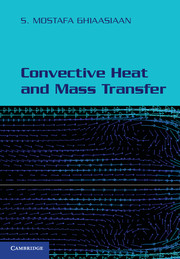Book contents
- Frontmatter
- Contents
- Preface
- Frequently Used Notation
- 1 Thermophysical and Transport Fundamentals
- 2 Boundary Layers
- 3 External Laminar Flow: Similarity Solutions for Forced Laminar Boundary Layers
- 4 Internal Laminar Flow
- 5 Integral Methods
- 6 Fundamentals of Turbulence and External Turbulent Flow
- 7 Internal Turbulent Flow
- 8 Effect of Transpiration on Friction, Heat, and Mass Transfer
- 9 Analogy Among Momentum, Heat, and Mass Transfer
- 10 Natural Convection
- 11 Mixed Convection
- 12 Turbulence Models
- 13 Flow and Heat Transfer in Miniature Flow Passages
- APPENDIX A Constitutive Relations in Polar Cylindrical and Spherical Coordinates
- APPENDIX B Mass Continuity and Newtonian Incompressible Fluid Equations of Motion in Polar Cylindrical and Spherical Coordinates
- APPENDIX C Energy Conservation Equations in Polar Cylindrical and Spherical Coordinates for Incompressible Fluids With Constant Thermal Conductivity
- APPENDIX D Mass-Species Conservation Equations in Polar Cylindrical and Spherical Coordinates for Incompressible Fluids
- APPENDIX E Thermodynamic Properties of Saturated Water and Steam
- APPENDIX F Transport Properties of Saturated Water and Steam
- APPENDIX G Properties of Selected Ideal Gases at 1 Atmosphere
- APPENDIX H Binary Diffusion Coefficients of Selected Gases in Air at 1 Atmosphere
- APPENDIX I Henry's Constant, in bars, of Dilute Aqueous Solutions of Selected Substances at Moderate Pressures
- APPENDIX J Diffusion Coefficients of Selected Substances in Water at Infinite Dilution at 25°C
- APPENDIX K Lennard–Jones Potential Model Constants for Selected Molecules
- APPENDIX L Collision Integrals for the Lennard–Jones Potential Model
- APPENDIX M Some RANS-Type Turbulence Models
- APPENDIX N Physical Constants
- APPENDIX O Unit Conversions
- APPENDIX P Summary of Important Dimensionless Numbers
- APPENDIX Q Summary of Some Useful Heat Transfer and Friction-Factor Correlations
- References
- Index
13 - Flow and Heat Transfer in Miniature Flow Passages
- Frontmatter
- Contents
- Preface
- Frequently Used Notation
- 1 Thermophysical and Transport Fundamentals
- 2 Boundary Layers
- 3 External Laminar Flow: Similarity Solutions for Forced Laminar Boundary Layers
- 4 Internal Laminar Flow
- 5 Integral Methods
- 6 Fundamentals of Turbulence and External Turbulent Flow
- 7 Internal Turbulent Flow
- 8 Effect of Transpiration on Friction, Heat, and Mass Transfer
- 9 Analogy Among Momentum, Heat, and Mass Transfer
- 10 Natural Convection
- 11 Mixed Convection
- 12 Turbulence Models
- 13 Flow and Heat Transfer in Miniature Flow Passages
- APPENDIX A Constitutive Relations in Polar Cylindrical and Spherical Coordinates
- APPENDIX B Mass Continuity and Newtonian Incompressible Fluid Equations of Motion in Polar Cylindrical and Spherical Coordinates
- APPENDIX C Energy Conservation Equations in Polar Cylindrical and Spherical Coordinates for Incompressible Fluids With Constant Thermal Conductivity
- APPENDIX D Mass-Species Conservation Equations in Polar Cylindrical and Spherical Coordinates for Incompressible Fluids
- APPENDIX E Thermodynamic Properties of Saturated Water and Steam
- APPENDIX F Transport Properties of Saturated Water and Steam
- APPENDIX G Properties of Selected Ideal Gases at 1 Atmosphere
- APPENDIX H Binary Diffusion Coefficients of Selected Gases in Air at 1 Atmosphere
- APPENDIX I Henry's Constant, in bars, of Dilute Aqueous Solutions of Selected Substances at Moderate Pressures
- APPENDIX J Diffusion Coefficients of Selected Substances in Water at Infinite Dilution at 25°C
- APPENDIX K Lennard–Jones Potential Model Constants for Selected Molecules
- APPENDIX L Collision Integrals for the Lennard–Jones Potential Model
- APPENDIX M Some RANS-Type Turbulence Models
- APPENDIX N Physical Constants
- APPENDIX O Unit Conversions
- APPENDIX P Summary of Important Dimensionless Numbers
- APPENDIX Q Summary of Some Useful Heat Transfer and Friction-Factor Correlations
- References
- Index
Summary
Miniature flow passages, defined here as passages with hydraulic diameters smaller than about 1 mm, have numerous applications. Some current applications include monolith chemical reactors, inkjet print-heads, bioengineering and biochemistry (lab-on-the-chip; drug delivery with ultrathin needles, etc.), microflow devices (micropumps, micro heat exchangers, etc.), and cooling systems for microelectronic and high-power magnets, to name a few. Miniature flow passages are an essential part of microfluidic devices, in which can be broadly defined as devices in which minute quantities of fluid are applied. Cooling systems based on microchannels can provide very large volumetric heat disposal rates that are unfeasible with virtually any other cooling technology. Their widespread future applications may in fact revolutionize some branches of medicine and industry.
The serious study of flow in capillaries (tubes with D ≈ 1 mm) goes back to at least the 1960s. The application of microchannels for cooling of high-power systems is relatively new, however (Tuckerman and Pease, 1981). The literature dealing with flow in microtubes is extensive. Useful reviews include those of Papautsky et al. (2001), Morini (2004), Krishnamoorthy et al. (2007), and Fan and Luo (2008). The field of flow in miniature channels, in particular with respect to very small channels (microfluidics and nanofluidics) is a rapidly developing one. In this chapter we review the flow regimes and size-based miniature flow passage categories, and we discuss the limitations of the classical convection heat and mass transfer theory with respect to its application to miniature flow passages.
- Type
- Chapter
- Information
- Convective Heat and Mass Transfer , pp. 397 - 448Publisher: Cambridge University PressPrint publication year: 2011



